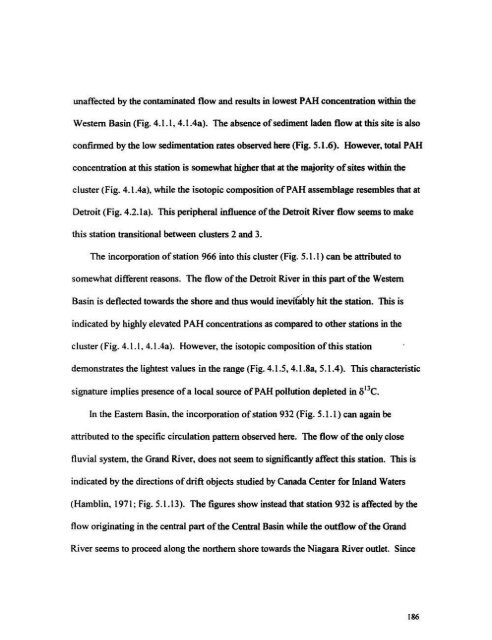I'r - Memorial University of Newfoundland
I'r - Memorial University of Newfoundland
I'r - Memorial University of Newfoundland
Create successful ePaper yourself
Turn your PDF publications into a flip-book with our unique Google optimized e-Paper software.
unaffected by the contaminated flow and results in lowest PAM concentration within the<br />
Western Basin (Fig. 4.1.1, 4.1.4a). The absence <strong>of</strong>sediment laden flow at this site is also<br />
confinned by the low sedimentation rates observed here (Fig. 5.1.6). However, total PAM<br />
concentration at this station is somewhat higher that at the majority <strong>of</strong>sites within the<br />
cluster (Fig. 4.I.4a), while the isotopic composition <strong>of</strong>PAH assemblage resembles that at<br />
Detroit (Fig. 4.2.la). This peripberallnfluence <strong>of</strong>the Detroit River flow seems to make<br />
this station transitional between clusters 2 and 3.<br />
The incorporation <strong>of</strong>station 966 into this cluster (Fig. 5.1.1) can be attributed to<br />
somewhat different reasons. The flow <strong>of</strong>the Detroit River in this part <strong>of</strong>the Western<br />
Basin is deflected towards the shore and thus would incvi&bly hit the station. This is<br />
indicated by high ly elevated PAH concentrations as compared to other stations in the<br />
cl uster (Fig. 4.1.1. 4.I.4a). However. the isotopi c composition <strong>of</strong>tbis station<br />
demonstrates the lightest values in the range (Fig. 4.1.5, 4.1 .83, 5.1.4). This characteristic<br />
signature implies presence <strong>of</strong>a local source <strong>of</strong>PAH pollution depleted in ,sIlC .<br />
In the Eastern Basin. the incorporation <strong>of</strong>station 932 (Fig. 5.LI) can again be<br />
attributed to the specific circulation pattern observed here . The flow <strong>of</strong>the only close<br />
fluvi al system, the Grand River , docs not seem to significantly affect this station. This is<br />
indicated by the directions <strong>of</strong>drift objects studied by Canada Center for lnJand Waters<br />
(Hamblin, 197 1; Fig. S.U 3). The figures show instead that station 932 is affectedby the<br />
flow originating in the central part <strong>of</strong>the Central Basin while the outflow <strong>of</strong>the Grand<br />
River seems to proceed along the northern shore towards the Niagara River outlet. Since<br />
186

















